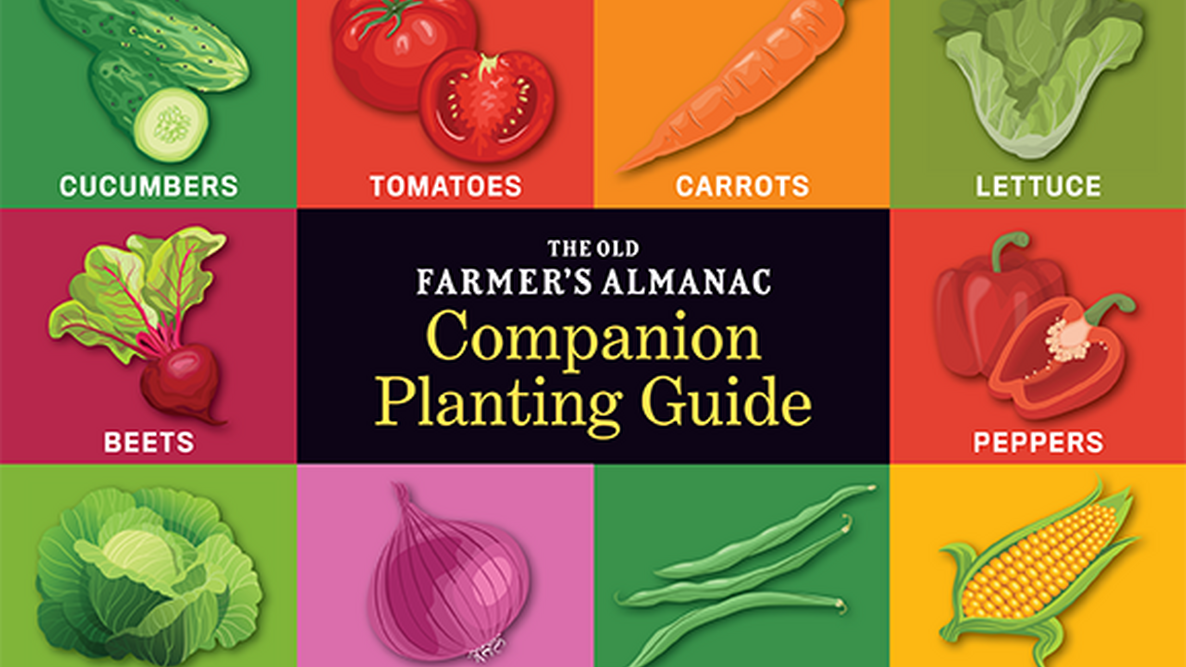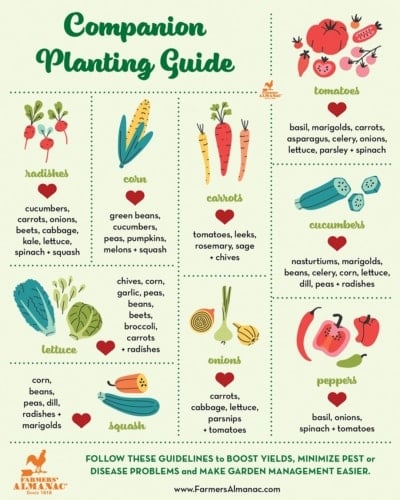The Farmer's Almanac Companion Planting Chart: A Musthave For Every Gardener
Companion planting is a gardening practice that involves planting certain vegetables and herbs together to benefit each other. By carefully selecting which plants to grow near each other, gardeners can improve the health, productivity, and pest resistance of their crops.
The Farmer's Almanac Companion Planting Chart is a valuable resource for gardeners of all levels of experience. The chart lists hundreds of different vegetables, herbs, and flowers, along with their ideal companions. It also includes information on which plants should be avoided planting together.
Using the Farmer's Almanac Companion Planting Chart can help you to:
- Grow healthier, more productive plants
- Attract beneficial insects and pollinators
- Repel pests and diseases
- Improve the overall health of your garden soil
If you're serious about gardening, then the Farmer's Almanac Companion Planting Chart is a must-have tool. It's a simple and effective way to boost the success of your garden.
Main Content
Here are some of the benefits of companion planting:
- Improved plant health: Companion plants can help to deter pests and diseases, attract beneficial insects and pollinators, and improve the overall health of the soil.
- Increased crop yields: Companion planting can help to increase the yields of your crops by improving pollination, providing shade, and deterring pests.
- Reduced workload: Companion planting can help to reduce the amount of work you need to do in your garden by attracting beneficial insects that will help to control pests, and by deterring weeds.
- Enhanced beauty: Companion planting can add beauty to your garden by creating a more natural and harmonious landscape.
How to Use the Farmer's Almanac Companion Planting Chart
The Farmer's Almanac Companion Planting Chart is easy to use. Simply find the vegetable or herb you want to plant, and then look at the list of recommended companions. You can also find a list of plants that should be avoided planting near each other.
Here are some tips for using the chart:
- Consider the size and growth habits of your plants. Some plants, such as tomatoes and cucumbers, need a lot of space to grow. Other plants, such as lettuce and spinach, can be grown in closer quarters.
- Think about the sunlight and water requirements of your plants. Some plants, such as beans and peas, need full sun. Other plants, such as carrots and potatoes, prefer partial shade.
- Consider the pests and diseases that are common in your area. Companion planting can help to deter pests and diseases, but it's important to choose plants that are resistant to the pests and diseases that are most common in your area.
Conclusion
The Farmer's Almanac Companion Planting Chart is a valuable resource for gardeners of all levels of experience. By using the chart, you can improve the health, productivity, and beauty of your garden.
If you're new to companion planting, start by choosing a few of your favorite vegetables or herbs. Then, consult the chart to find out which plants are good companions for them. Once you've planted your garden, keep an eye on the plants and make adjustments as needed. With a little practice, you'll be a companion planting pro in no time!
Do you want to grow a healthy and productive garden? If so, you should consider using companion planting. Companion planting is a gardening technique that involves planting certain plants together to benefit each other. For example, some plants attract beneficial insects that help to control pests, while others improve the soil quality or deter diseases.
The Farmers' Almanac has a comprehensive companion planting chart that can help you choose the right plants for your garden. The chart lists which vegetables and flowers grow well together, as well as which ones should be avoided. It also includes information on the benefits of companion planting, as well as tips on how to implement it in your own garden.
To learn more about companion planting and to see the Farmers' Almanac companion planting chart, visit Gardenia Inspiration.
FAQ of farmers almanac companion planting chart
- What is companion planting?
Companion planting is a gardening technique of planting certain crops together to benefit each other. Some plants can attract beneficial insects, deter pests, or improve the soil quality of the area around them. By planting these plants together, you can create a more balanced and productive garden.
- Where can I find a companion planting chart?
There are many different companion planting charts available online and in gardening books. The Farmers' Almanac has a comprehensive companion planting chart that lists which vegetables and flowers are good companions for each other. You can also find companion planting charts specific to your region or climate.
- How do I use a companion planting chart?
To use a companion planting chart, first identify the vegetables or flowers you want to grow in your garden. Then, look up each plant on the chart to see which other plants are good companions for it. You can plant these companion plants together in the same bed or plot.
- What are some of the benefits of companion planting?
There are many benefits to companion planting, including:
- Increased crop yields
- Reduced pest and disease problems
- Improved soil quality
- Increased biodiversity in the garden
- Attracted pollinators
- What are some of the challenges of companion planting?
There are a few challenges to companion planting, such as:
- It can be time-consuming to research which plants are good companions for each other.
- It can be difficult to find all of the companion plants you need at your local nursery or garden center.
- Companion planting may not work as well in all climates or conditions.
Image of farmers almanac companion planting chart
- Image 1: This image shows a large companion planting chart with vegetables and herbs organized by color. The chart also includes information on the benefits of companion planting, such as pest control, pollination, and soil improvement.

- Image 2: This image shows a close-up of the companion planting chart in image 1. The chart is divided into three sections: Beneficial Companions, Neutral Companions, and Harmful Companions.

- Image 3: This image shows a companion planting chart that is specifically designed for vegetable gardens. The chart includes information on the best companions for a variety of vegetables, such as tomatoes, cucumbers, and carrots.

- Image 4: This image shows a companion planting chart that is specifically designed for herb gardens. The chart includes information on the best companions for a variety of herbs, such as basil, mint, and rosemary.

- Image 5: This image shows a companion planting chart that is specifically designed for flower gardens. The chart includes information on the best companions for a variety of flowers, such as marigolds, nasturtiums, and sunflowers.

Post a Comment for "The Farmer's Almanac Companion Planting Chart: A Musthave For Every Gardener"